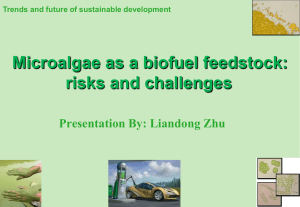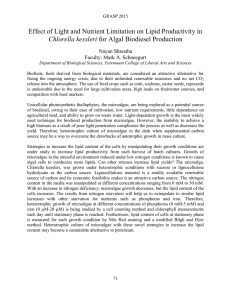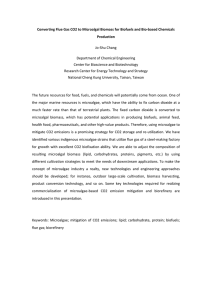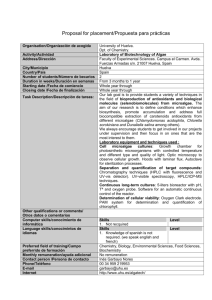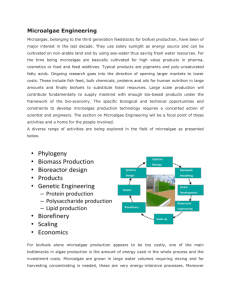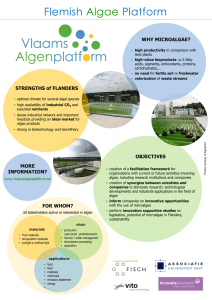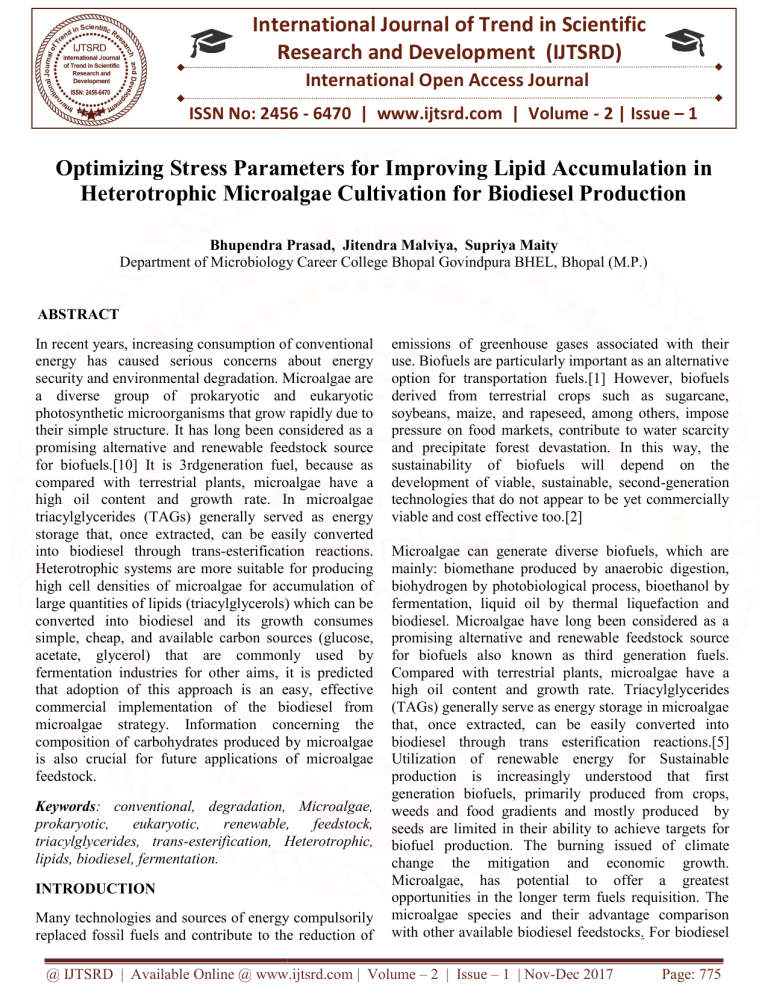
International Journal of Trend in Scientific
Research and Development (IJTSRD)
International Open Access Journal
ISSN No: 2456 - 6470 | www.ijtsrd.com | Volume - 2 | Issue – 1
Optimizing Stress Parameters for Improving Lipid Accumulation in
Heterotrophic Microalgae Cultivation for
or Biodiesel Production
Bhupendra Prasad, Jitendra Malviya, Supriya Maity
Department of Microbiology Career College Bhopal Govindpura BHEL, Bhopal (M.P.)
ABSTRACT
In recent years, increasing consumption of conventional
energy has caused serious concerns about energy
security and environmental degradation. Microalgae are
a diverse group off prokaryotic and eukaryotic
photosynthetic microorganisms that grow rapidly due to
their simple structure. It has long been considered as a
promising alternative and renewable feedstock source
for biofuels.[10] It is 3rdgeneration fuel, because as
comparedd with terrestrial plants, microalgae have a
high oil content and growth rate. In microalgae
triacylglycerides (TAGs) generally served as energy
storage that, once extracted, can be easily converted
into biodiesel through trans-esterification
esterification reactions.
Heterotrophic
terotrophic systems are more suitable for producing
high cell densities of microalgae for accumulation of
large quantities of lipids (triacylglycerols) which can be
converted into biodiesel and its growth consumes
simple, cheap, and available carbon source
sources (glucose,
acetate, glycerol) that are commonly used by
fermentation industries for other aims, it is predicted
that adoption of this approach is an easy, effective
commercial implementation of the biodiesel from
microalgae strategy. Information concernin
concerning the
composition of carbohydrates produced by microalgae
is also crucial for future applications of microalgae
feedstock.
Keywords:: conventional, degradation, Microalgae,
prokaryotic,
eukaryotic,
renewable,
feedstock,
triacylglycerides, trans-esterification,
on, Heterotrophic,
lipids, biodiesel, fermentation.
INTRODUCTION
Many technologies and sources of energy compulsorily
replaced fossil fuels and contribute to the reduction of
emissions of greenhouse gases associated with their
use. Biofuels are particularly important as an alternative
option for transportation fuels.[1]
fuels.
However, biofuels
derived from terrestrial crops such as sugarcane,
soybeans, maize, and rapeseed, among others, impose
pressure on food markets, contribute to water scarcity
and precipitate forest devastation. In this way, the
sustainability of biofuels will depend on the
development of viable, sustainable, second-generation
second
technologies that do not appear to be yet commercially
viable and cost effective too.[2]
[2]
Microalgae can generate diverse biofuels, which are
mainly: biomethane produced by anaerobic digestion,
biohydrogen by photobiological process, bioethanol by
fermentation, liquid oil by thermal liquefaction and
biodiesel. Microalgae have long been considered as a
promising alternative and renewable
renewabl feedstock source
for biofuels also known as third generation fuels.
Compared with
th terrestrial plants, microalgae have a
high oil content and growth rate. Triacylglycerides
(TAGs) generally serve as energy storage in microalgae
that, once extracted, can be easily converted into
biodiesel through trans esterification
est
reactions.[5]
Utilization of renewable energy for Sustainable
production is increasingly understood that first
generation biofuels, primarily produced from crops,
weeds and food gradients and mostly produced by
seeds are limited in their ability
abil to achieve targets for
biofuel production. The
he burning issued
issue of climate
change the mitigation and economic growth.
Microalgae, has potential to offer a greatest
opportunities in the longer term fuels requisition. The
microalgae species and their advantage comparison
with other available biodiesel feedstocks. For biodiesel
@ IJTSRD | Available Online @ www.ijtsrd.com | Volume – 2 | Issue – 1 | Nov-Dec
Dec 2017
Page: 775
International Journal of Trend in Scientific Research and Development (IJTSRD) ISSN: 2456-6470
production, cultivation, harvesting, and processing
microalgae is very high in demand. The various
aspects associated with the design of microalgae
production units are described, giving an overview of
the current state of development of algae cultivation
systems (photo-bioreactors and open ponds). Other
potential applications and products from microalgae are
also presented such as for biological sequestration of
CO2, wastewater treatment, in human health, as food
additive, and for aquaculture. [8, 3]The main objective
of the study to Isolation of pure strains from mixed
microalgae to optimizing stress parameters for
improving lipid accumulation in mixed microalgae and
microalgae isolates in heterotrophic conditions.
Heterotrophic cultivation may allow large volume
applications such as wastewater treatment combined, or
Culture
Carbon source
Other source
separated, with production of biofuels. Heterotrophic
cultivation can overcome the limitations faced in open
pond and large-scale PBRs.[6]
Material and Method
Sample Collection
Collection of fresh water-borne microalgae inoculums
from water bodies for analysis of fresh microalgae with
their Biomass density, Chlorophyll, Lipid content and
feed preparation for heterotrophic growth of algae.
Fresh water needs to be added to raceway pond systems
to compensate evaporation; water may also be used to
cool some PBR designs.
Treatment
15g/L dextrose
1X DSW
Control
1X DSW
Table 1. Feed composition
Fig.1. Collection and analysis of Microalgae
@ IJTSRD | Available Online @ www.ijtsrd.com | Volume – 2 | Issue – 1 | Nov-Dec 2017
Page: 776
International Journal of Trend in Scientific Research and Development (IJTSRD) ISSN: 2456-6470
Fig.2. Methodology for heterotrophic growth
Transferred 160mL of feed into 5 250mL flasks (control methanol for extracting total Lipids) (n Hexane for
and 4 flasks with treatment) after that inoculated 20ml extracting neutral Lipids).[4]
wet biomass of micro algae and culturing for 16 days in
heterotrophic conditions.
Gravimetric estimation
Solvents with dissolved lipids are centrifuged and
CO2
Bioremediation
by
microalgae
in transferred to aromatic vials and solvent is evaporated.
Photobioreactors
Microalgae have the potential to recycle and Through gravimetric estimation lipid percentage in
bioremediate CO2 and also produce chemical energy in microalgae is estimated. Taken 2ml vials loaded with
the form of biomass. The potential production of 10mg of dried algal biomass loaded along with 2ml
renewable energy and high value products (i.e. solvent and Kept for sonication in the Dark
carotenoid, antioxidants and polyunsaturated fatty acids) Heterotrophic conditions for
(16 days) Photo
make large scale microalgal cultivation an attractive Heterotrophic conditions for (16 days) Photo
application. Initially, feed was analyzed before heterotrophic for (8 days) + Dark heterotrophic for (8
inoculation of microalgae. Nutrients removal is observed days). The extraction was repeated three times, and all
by analyzing the nitrates, phosphates and carbohydrates the extracts were combined into a pre-weighed glass
in the feed in alternative days. Feed Samples are tube, and then dried under nitrogen protection.
collected at five intervals in 16 days cycle for COD
removal tests.[3]
Result and Discussion
Biomass Study
Algae biomass density and carbohydrate accumulation
in algae are also analyzed at alternative days. Lipid
accumulation in the algae analyzed in the interval for 4
days in the flasks 1, 2, 3 and 4 respectively.
Lipid Analysis by Sonication
For knowing lipid content at different time intervals
Microalgae Biomass collected from culture flasks and
dried under sunlight. Dried biomass grinded and beaded
in different solvents. (2:1 v/v Ratio chloroform to
CO2
Bioremediation
Photobioreactors
by
microalgae
in
The addition of CO2 is required for the autotrophic
growth of microalgae, and is considered to be positively
related to the efficiency of photosynthesis, with the
synthesis of carbohydrates as the end product. A
sufficient supply of CO2 is thus one of the key factors
influencing the accumulation of carbohydrate in
microalgae. Some studies found that carbohydrate
accumulation in microalgae is improved by increasing
the percentage of CO2 in the inlet gas [4, 8]. For
@ IJTSRD | Available Online @ www.ijtsrd.com | Volume – 2 | Issue – 1 | Nov-Dec 2017
Page: 777
International Journal of Trend in Scientific Research and Development (IJTSRD) ISSN: 2456-6470
example, Xia and Gao [4] pointed out that increasing
dissolved CO2 concentration from 3 to 186 _mol/L in
the cultivation of C. pyrenoidosa and C. reinhardtii
could elevate the carbohydrate content from 9.30 to
21.0% and 3.19 to 7.40% (w/w), respectively. However,
many researchers believe that increasing the CO2
concentration not only provides more carbon source for
photosynthesis to promote microalgae growth, but also
induces the synthesis of relevant proteins, which may
influence the cell physiology. In some microalgal
species, increases in the CO2 concentration result in an
increase in the protein content, but a decrease or no
obvious change in the carbohydrate content [7, 9].
However, under nitrogen starvation conditions and with
an adequate supply of CO2 and light energy, the protein
content in microalgae can be consumed as a nitrogen
source, and the carbohydrate content may increase
significantly during this process. Therefore, suitable
addition of CO2 is a key step to improving the
autotrophic growth of microalgal cells (i.e., improving
biomass productivity and protein content), although it
may not directly enhance carbohydrate accumulation in
microalgae, unless appropriate stress conditions are
employed.
Biomass Study
Fuels made from living biomass rather than organisms
fossilised some 200 million years ago have attracted
worldwide attention – and suspicion. While
development continues apace, first and second
generation fuels based on terrestrial plants are
controversial because they require cultivation resources
that could otherwise be used for growing food.
Structural carbohydrates can constitute a large fraction
of the dry weight of algal biomass and thus accurate
identification and quantification is important for
summative mass closure. The comparison was based on
the resolution and quantification of monosaccharides
obtained after analytical hydrolysis of algal biomass
with H2SO4. [11,12]
Gravimetric estimation
These valuable chromatography tools have allowed us to
characterize the monosaccharides released after sulfuric
acid hydrolysis of three types of algae. Further work in
structural carbohydrate release, either by chemical or
enzymatic hydrolysis, will shed light on not only the
total carbohydrate content in algae, but also the
understanding of the structure of algal polymeric
carbohydrates. This knowledge can be applied to
conversion and fermentation experimental work as well
as guide research into cell wall degradation procedures
to aid with simultaneous oil extraction and release of
soluble sugars. A linear correlation between chlorophyll
and ammonium concentration in the culture was
observed for the experiments at 20°C and 25 °C (Fig.
3C). The pattern suggests that the consumption of this
compound was associated with microalgal growth,
nevertheless, ammonium may have been also depleted
by abiotic phenomena such as stripping related to the
high pH levels induced by the photosynthetic activity
(see later) and respired by nitrifying bacteria.[13] The
carbohydrate production ability of microalgae varies
from species to species. However, as mentioned earlier,
the production of microalgal carbohydrates can be
significantly improved when appropriate cultivation
conditions are applied. Summarizes the performance of
the biomass and carbohydrates production of various
microalgae species according to recent reports in the
literature, showing that the microalgal carbohydrate
productivity varies in a wide range from 0.021 to 0.687
g/L/d. Our recent work showed that C. vulgaris FSP-E
can achieve the highest carbohydrates productivity of
0.687 g/L/d due to a high biomass productivity of 1.363
g/L/d. Information concerning the composition of
carbohydrates produced by microalgae is also crucial for
future applications of microalgae feedstock. However,
this information is currently very limited, as only two
Chlorella strains.
@ IJTSRD | Available Online @ www.ijtsrd.com | Volume – 2 | Issue – 1 | Nov-Dec 2017
Page: 778
International Journal of Trend in Scientific Research and Development (IJTSRD) ISSN: 2456-6470
Fig 3. OPTIMIZING GROWTH PHASE (Cycle 1) :-Biomass studies
( A) algae biomass density(A)
(B) Internal carbohydrates(mg/L)
3.5
600
3
500
2.5
control
2
400
1st
300
2nd
1.5
3rd
1
200
4th
0.5
100
0
0
2
4
6
0
8
0
2
4
6
8
OPTIMIZING GROWTH PHASE (Cycle 1) :-Biomass studies (C) Chlorophyll content(mg/L)
0.12
0.1
control
0.08
1st
0.06
2nd
3rd
0.04
4th
0.02
0
0
1
2
3
4
5
6
7
8
NH4+ removal rates in all the cultures showed in the graph at higher temperatures increased and longer
photoperiods PO43− and NH4+ were not removed.[7] This is in agreement with the absence of biological activity in
those cultures. Neither biomass production nor nitrification was observed in these conditions (Fig. 4 (A & B).
When correlating the concentration of the residual phosphate in the medium with the chlorophyll concentration of
the culture (algal biomass), the correlation coefficients were low (Fig. 4B). This suggested that factors other than
assimilation could be at play. Su et al. observed phosphate removal efficacies ranging from 56 to 73% in batch
cultures (8 days of incubation) with a low nitrogen/phosphorus ratio (N/P = 3:1). This low level of phosphate
depletion was attributed to nitrogen limitation encountered by the cultures. The variation in chlorophyll and
phosphate concentrations over time were tested at two temperatures and photoperiods tested (Fig. 3 C). During the
first 50 h of the experiment the phosphate concentration fell significantly. At 15 °C, the algae could have
accumulated phosphate even though during this period the algal biomass remained approximately constant (Fig.
3A and b). The fall in the phosphate concentration may be due to adsorption on the cell surface, which has been
previously reported to contribute significantly to phosphorus removal from wastewater. At the beginning of the
experiment, the magnitude of phosphorus removal was not affected by temperature or photoperiod. This
observation could also be explained by adsorption.
@ IJTSRD | Available Online @ www.ijtsrd.com | Volume – 2 | Issue – 1 | Nov-Dec 2017
Page: 779
International Journal of Trend in Scientific Research and Development (IJTSRD) ISSN: 2456-6470
Phosphate removal and biomass production correlated well from 50 h incubation onwards (Fig. 4 B). From
approximately 100 h (168 h for the culture B15–12) onwards the pH of the cultures rose above 9.5. At this
elevated pH, the chemical precipitation of phosphorus is possible and in every graph it can be seen that complete
phosphate removal occurs at this pH. No phosphate removal was detected for cultures in darkness where pH
values were between 7.8 and 8.3 all along the incubation period.
Fig 4. OPTIMIZING GROWTH PHASE (Cycle 1) :-Bioremediation studies
(A) Nitrates removal (mg/L)
(B)Phosphates removal (mg/L)
35
300
30
250
25
200
control
20
1st
2nd
15
3rd
4th
control
1st
150
2nd
3rd
100
4th
10
50
5
0
0
0
0
2
4
6
5
10
8
@ IJTSRD | Available Online @ www.ijtsrd.com | Volume – 2 | Issue – 1 | Nov-Dec 2017
Page: 780
International Journal of Trend in Scientific Research and Development (IJTSRD) ISSN: 2456-6470
(C) Carbohydrates removal (mg/L)
5000
(D) COD removal(mg/L)
20000
4500
18000
4000
16000
3500
14000
3000
12000
2500
10000
8000
2000
6000
1500
c
o
nt
r
ol
1000
500
4000
2000
0
0th day
0
0
2
4
6
4th day
8th day
12th day 16th day
8
Lipid Analysis by Sonication
Lipid extracted microalgal biomass residues (LMBRs) using conventional anaerobic activated sludge fermentation
technology, generating a new concept for use in biorefineries. Yang et al. [15] showed that the highest biohydrogen
yield of 45.54 mL/g-VS was achieved from LMBRs that underwent thermo-alkaline pretreatment at 100 ◦C, with
this being approximately three-fold higher than the yield from untreated LMBRs. In addition, there has recently
been growing research attention focused on biogas production from microalgae [16]. However, it is worth noting
that the anaerobic digestion process cannot be economically competitive unless it is targeted to treat the microalgal
residues remaining after the production of high grade biofuels, such as bioethanol and biobutanol, or unless it is
integrated into a microalgae biorefinery [2].
Fig 5. Lipid Analysis
30.00%
25.00%
20.00%
15.00%
Total Lipid
10.00%
Neutral Lipid
5.00%
0.00%
Mother control 4th day 8th day 12th day 16th day
Culture
@ IJTSRD | Available Online @ www.ijtsrd.com | Volume – 2 | Issue – 1 | Nov-Dec 2017
Page: 781
International Journal of Trend in Scientific Research and Development (IJTSRD) ISSN: 2456-6470
Time Interval
Mother Culture
control
4th day
8th day
12th day
16th day
Table 2. Analysis of Lipids
Total Lipid
Neutral Lipid
4.5%
1.4%
11%
4%
23%
7%
22%
5%
24%
9%
22%
8%
Under unfavorable and stress conditions microalgae reprogram its pathway towards formation and accumulation of
neutral lipids. Heterotrophic growth consumes simple, cheap, and available carbon sources (glucose, acetate,
glycerol) that are commonly used by fermentation industries for other aims, it is predicted that adoption of this
approach is an easy, uncomplicated task.
References
1) Chun-Yen Chen, Xin-Qing Zhao, Hong-Wei Yen,
Shih-Hsin Ho, Chieh-Lun Cheng,Duu-Jong Lee,
Feng-Wu Bai, Jo-Shu Chang. Microalgae-based
carbohydrates for biofuel production. Biochemical
engineering Journal 78 (2013) 1– 10.
2) J.H. Mussgnug, V. Klassen, A. Schluter, O. Kruse,
Microalgae as substrates for fermentative
a. biogas production in a combined biorefinery
concept, J. Biotechnol.150 (2010) 51–56.
3) J.R. Xia, K.S. Gao, Impacts of elevated CO2
concentration on biochemical composition,
carbonic anhydrase, and nitrate reductase activity
of freshwater green algae, J. Integr. Plant Biol. 47
(2005) 668– 675.
4) Kalpesh K. Sharma, Holger Schuhmann and Peer
M. Schenk “High Lipid Induction in Microalgae for
Biodiesel Production” Energies 2012, 5, 15321553;
5) Michael B. Johnson and Zhiyou Wen “Production
of Biodiesel Fuel from the Microalga
Schizochytrium
limacinum
by
Direct
Transesterification of Algal Biomass Energy Fuels
2009, 23, 5179–5183
6) Octavio Perez-Garcia “Heterotrophic cultures of
microalgae: Metabolism and potential products”
water research 45 ( 2011 ).
7) M. Giordano, Interactions between C and N
metabolism in Dunaliella salina cells cultured at
elevated CO2 and high N concentrations, J. Integr.
Plant Biol.158 (2001) 577–581.
8) M.R. Brown, S.W. Jeffrey, J.K. Volkman, G.A.
Dunstan, Nutritional properties of microalgae for
mariculture, Aquaculture 151 (1997) 315–331.
9) Srikanth Reddy Medipally,1 Fatimah Md.
Yusoff,1,2 Sanjoy Banerjee,1 andM. Shariff1,3
Microalgae as Sustainable Renewable Energy
Feedstock for Biofuel Production BioMed Research
International Volume 2015, Article ID 519513, 13
pages http://dx.doi.org/10.1155/2015/519513
10) Tahani S. Gendy *, Seham A. El-Temtamy.
Commercialization potential aspects of microalgae
for biofuel production: An overview. Egyptian
Journal of Petroleum (2013) 22, 43–51
11) Xiaobin Wen1, Kui Du1,2, Zhongjie Wang1, Xinan
Peng1,2, Liming Luo1,3, Huanping Tao1, Yan
Xu1,2, Dan Zhang1, Yahong Geng1 and Yeguang
Li1*.Effective cultivation of microalgae for biofuel
production: a pilot‑scale evaluation of a novel
oleaginous microalga Graesiella sp. WBG‑1. Wen
et al. Biotechnol Biofuels (2016) 9:123 DOI
10.1186/s13068-016-0541-y.
12) Xuefeng Lu1 “A Perspective: Photosynthetic
Production of Fatty Acid-Based Biofuels in
Genetically Engineered Cyanobacteria”
13) Yanqun Li & Mark Horsman & Bei Wang “Effects
of nitrogen sources on cell growth and lipid
accumulation
of
green
alga
Neochloris
oleoabundans Yanqun Li & Mark Horsman & Bei
Wang“Appl Microbiol Biotechnol (2008) 81:629–
636
14) Z.M. Yang, R.B. Guo, X.H. Xu, X.L. Fan, X.P. Li,
Enhanced hydrogen production from lipid-extracted
microalgal biomass residues through pretreatment,
Int. J.Hydrogen Energy 35 (2010) 9618–9623.
15) P. Collet, A. Helias, L. Lardon, M. Ras, R.A. Goy,
J.P. Steyer, Life-cycle assessment of microalgae
culture coupled to biogas production, Bioresour.
Technol.
102
(2011)
207–214.
@ IJTSRD | Available Online @ www.ijtsrd.com | Volume – 2 | Issue – 1 | Nov-Dec 2017
Page: 782

